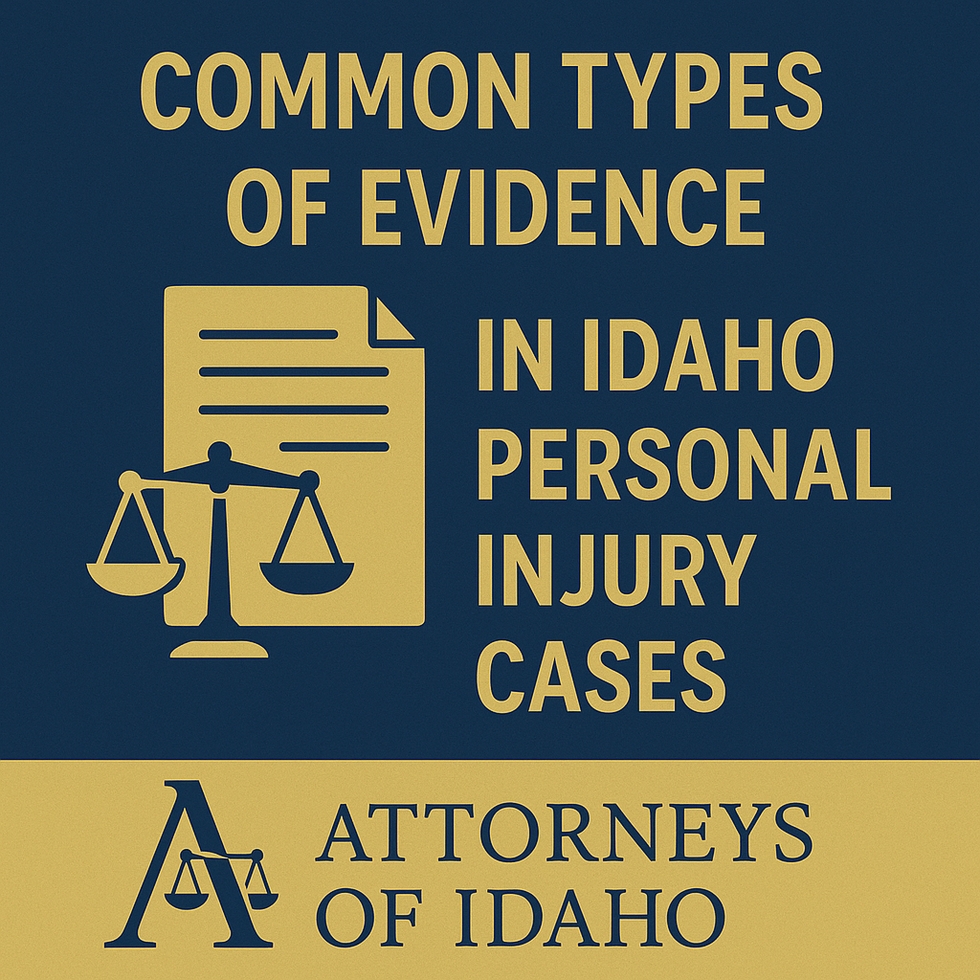
When you’re injured in an accident caused by someone else’s negligence—whether it’s a car crash on I-84, a slip-and-fall at a Boise grocery store, or a dog bite in a Twin Falls neighborhood—the strength of your personal injury case comes down to one key factor: evidence.
In Idaho, as in all states, personal injury claims rely on the injured party’s ability to prove that another person or entity acted carelessly or wrongfully, and that this behavior directly caused harm. The burden of proof is on the plaintiff. That’s why having the right evidence can make or break your case.
This post breaks down the most common types of evidence used in Idaho personal injury cases, why each type matters, and how they fit into the broader legal process.
1. Medical Records and Bills
Medical documentation is the backbone of almost every personal injury case. It proves not only that you were injured, but also the extent, nature, and cost of those injuries.
Typical medical evidence includes:
- Emergency room records
- Doctor’s notes and diagnoses
- Imaging reports (X-rays, MRIs, CT scans)
- Treatment plans and therapy records
- Prescription receipts
- Mental health evaluations (when emotional trauma is involved)
In Idaho, these records help establish both economic damages (like medical costs) and non-economic damages (such as pain and suffering). The more detailed and consistent your medical documentation is, the stronger your claim will be.
2. Photographs and Videos
Visual evidence is compelling, especially in front of an Idaho jury. Photos and videos can vividly capture the scene of the accident, vehicle damage, injuries, weather conditions, and any hazardous circumstances.
Common examples include:
- Vehicle damage after a collision
- Skid marks, road signs, or traffic lights at the accident scene
- Unsafe conditions (like icy sidewalks or broken handrails)
- Visible injuries like bruises, cuts, or swelling
- Surveillance or dashcam footage of the incident
If you’re able, it’s wise to document the scene immediately after an accident—before anything changes or is cleaned up.
3. Police Reports and Incident Reports
In Idaho, law enforcement officers are required to file a police report for any accident involving injury, death, or significant property damage. These reports often include:
- Officer observations and diagrams
- Driver and witness statements
- Citations or indications of fault
- Insurance information
Police reports aren’t always admissible as evidence in trial (due to hearsay rules), but they are critical during settlement negotiations and help insurance adjusters evaluate claims.
For non-vehicle incidents (like falls in a store or injuries at a workplace), incident reports filed with the business or property owner serve a similar role. Always request a copy of any incident report if one exists.
4. Eyewitness Testimony
Eyewitnesses can support your version of events and counter attempts by the other party to shift blame. In Idaho, a neutral third-party witness—someone with no stake in the outcome—can carry significant weight.
Eyewitnesses may testify about:
- How the accident happened
- Whether warning signs or safety measures were in place
- The behavior of the defendant before and after the incident
- Your immediate physical or emotional condition
It’s important to gather contact information from witnesses at the scene and follow up with them quickly while their memory is still fresh.
5. Expert Testimony
In more complex personal injury cases, expert witnesses may be needed to explain technical details, especially in trials. These experts can include:
- Accident reconstructionists (for car crashes)
- Medical professionals (to explain long-term impact of injuries)
- Economists (to calculate future lost income)
- Vocational experts (to assess loss of earning capacity)
- Mental health professionals (for emotional distress claims)
Idaho courts generally accept expert testimony as long as it meets relevance and reliability standards set by the Idaho Rules of Evidence.
6. Employment and Income Records
If your injuries caused you to miss work or diminished your ability to earn, you’ll need to back that up with documentation. In Idaho, lost wages and loss of future earning capacity are recoverable damages.
Relevant documents include:
- Pay stubs
- Tax returns (usually 2–3 years prior to the injury)
- Employer letters confirming missed time
- Time-off requests and disability filings
This evidence helps quantify your economic losses and demonstrates how the injury has impacted your livelihood.
7. Personal Journals and Testimony
While more subjective, personal diaries and testimony from the injured person can help prove pain and suffering, loss of enjoyment of life, and other non-economic damages.
You can document:
- Physical symptoms (pain levels, mobility issues)
- Emotional challenges (anxiety, PTSD, depression)
- Daily limitations (missed events, disrupted routines)
- Ongoing treatment and medication side effects
In Idaho, non-economic damages are capped in most personal injury cases (currently around $500,000), but strong narrative evidence can still influence jury awards and settlement negotiations.
8. Insurance Communications and Claims Documents
Keep detailed records of all correspondence with insurance companies, including:
- Letters, emails, and claim forms
- Statements you provide to adjusters
- Denials or lowball offers
- Settlement proposals
In some Idaho cases, this documentation becomes critical in bad faith insurance claims, especially if the insurer unreasonably denies a legitimate claim or delays payment.
Conclusion
In any Idaho personal injury case, strong evidence is your most important ally. Whether you’re negotiating with an insurance company or presenting your case in court, your ability to clearly document what happened—and how it affected you—can determine whether you receive fair compensation.
The evidence doesn’t have to be overwhelming, but it does need to be organized, consistent, and credible. From medical records to eyewitness testimony and photos of the scene, gathering the right materials early and thoroughly gives you the best chance of success under Idaho’s personal injury laws.
If you’ve been injured and are considering a claim, start building your evidence file immediately. Even small details can become critical pieces of the bigger picture.

